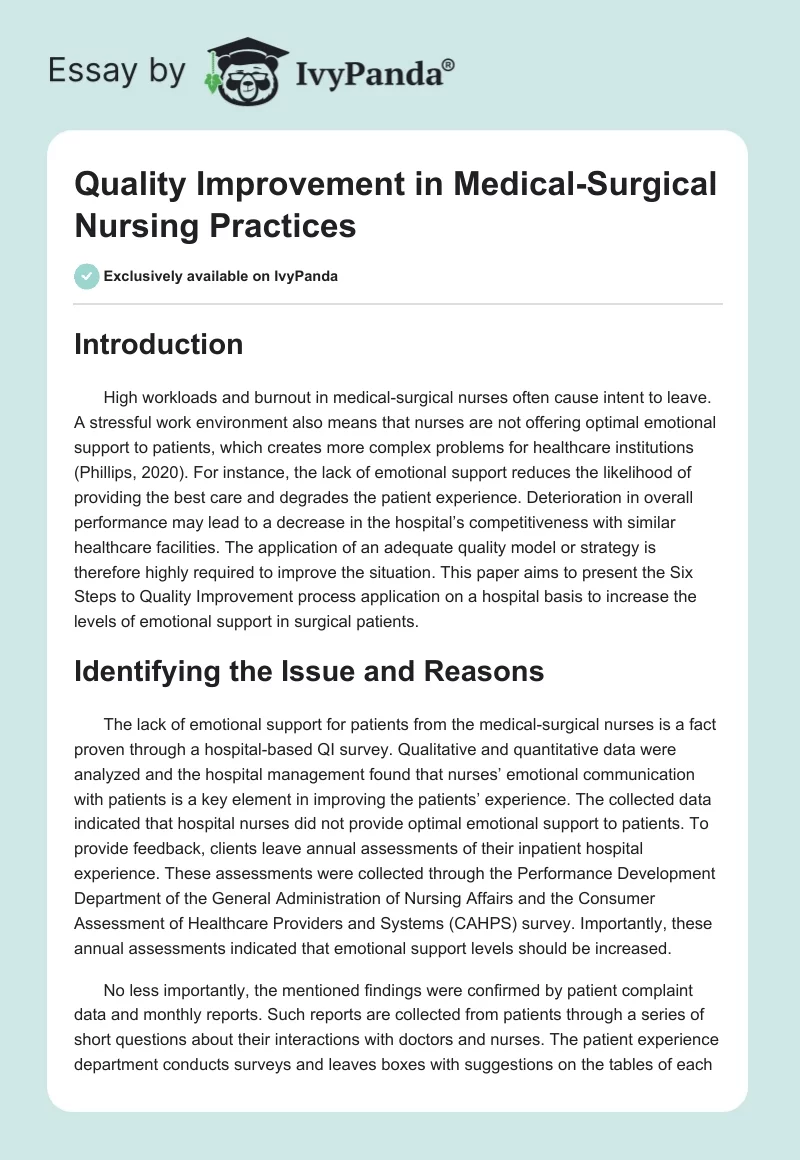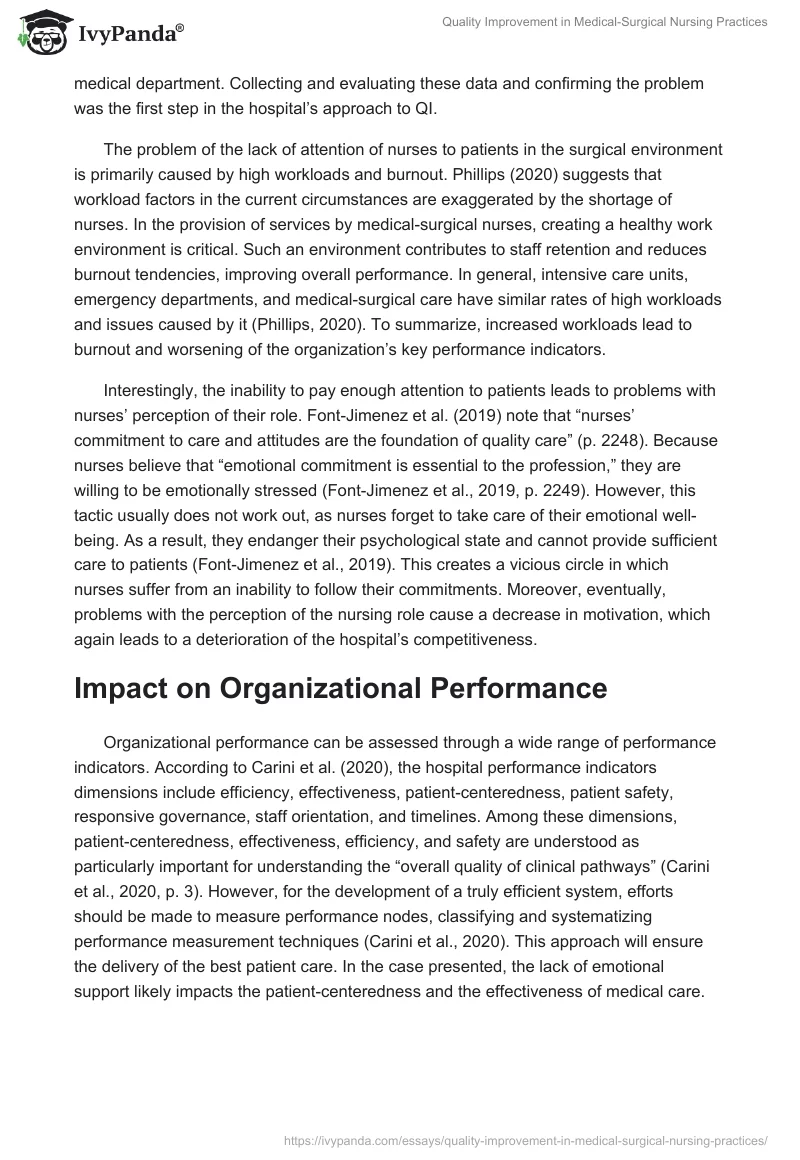Introduction
High workloads and burnout in medical-surgical nurses often cause intent to leave. A stressful work environment also means that nurses are not offering optimal emotional support to patients, which creates more complex problems for healthcare institutions (Phillips, 2020). For instance, the lack of emotional support reduces the likelihood of providing the best care and degrades the patient experience. Deterioration in overall performance may lead to a decrease in the hospital’s competitiveness with similar healthcare facilities. The application of an adequate quality model or strategy is therefore highly required to improve the situation. This paper aims to present the Six Steps to Quality Improvement process application on a hospital basis to increase the levels of emotional support in surgical patients.
Identifying the Issue and Reasons
The lack of emotional support for patients from the medical-surgical nurses is a fact proven through a hospital-based QI survey. Qualitative and quantitative data were analyzed and the hospital management found that nurses’ emotional communication with patients is a key element in improving the patients’ experience. The collected data indicated that hospital nurses did not provide optimal emotional support to patients. To provide feedback, clients leave annual assessments of their inpatient hospital experience. These assessments were collected through the Performance Development Department of the General Administration of Nursing Affairs and the Consumer Assessment of Healthcare Providers and Systems (CAHPS) survey. Importantly, these annual assessments indicated that emotional support levels should be increased.
No less importantly, the mentioned findings were confirmed by patient complaint data and monthly reports. Such reports are collected from patients through a series of short questions about their interactions with doctors and nurses. The patient experience department conducts surveys and leaves boxes with suggestions on the tables of each medical department. Collecting and evaluating these data and confirming the problem was the first step in the hospital’s approach to QI.
The problem of the lack of attention of nurses to patients in the surgical environment is primarily caused by high workloads and burnout. Phillips (2020) suggests that workload factors in the current circumstances are exaggerated by the shortage of nurses. In the provision of services by medical-surgical nurses, creating a healthy work environment is critical. Such an environment contributes to staff retention and reduces burnout tendencies, improving overall performance. In general, intensive care units, emergency departments, and medical-surgical care have similar rates of high workloads and issues caused by it (Phillips, 2020). To summarize, increased workloads lead to burnout and worsening of the organization’s key performance indicators.
Interestingly, the inability to pay enough attention to patients leads to problems with nurses’ perception of their role. Font-Jimenez et al. (2019) note that “nurses’ commitment to care and attitudes are the foundation of quality care” (p. 2248). Because nurses believe that “emotional commitment is essential to the profession,” they are willing to be emotionally stressed (Font-Jimenez et al., 2019, p. 2249). However, this tactic usually does not work out, as nurses forget to take care of their emotional well-being. As a result, they endanger their psychological state and cannot provide sufficient care to patients (Font-Jimenez et al., 2019). This creates a vicious circle in which nurses suffer from an inability to follow their commitments. Moreover, eventually, problems with the perception of the nursing role cause a decrease in motivation, which again leads to a deterioration of the hospital’s competitiveness.
Impact on Organizational Performance
Organizational performance can be assessed through a wide range of performance indicators. According to Carini et al. (2020), the hospital performance indicators dimensions include efficiency, effectiveness, patient-centeredness, patient safety, responsive governance, staff orientation, and timelines. Among these dimensions, patient-centeredness, effectiveness, efficiency, and safety are understood as particularly important for understanding the “overall quality of clinical pathways” (Carini et al., 2020, p. 3). However, for the development of a truly efficient system, efforts should be made to measure performance nodes, classifying and systematizing performance measurement techniques (Carini et al., 2020). This approach will ensure the delivery of the best patient care. In the case presented, the lack of emotional support likely impacts the patient-centeredness and the effectiveness of medical care.
Six Steps to Quality Improvement
Given the decrease in the quality of services due to a lack of emotional support, a quality model to solve the issue should be developed. In particular, the Six Steps Quality Improvement process can be applied (Singh & Rathi, 2018). This model is ideal for planning and implementing strategic change initiatives. It aims to find the best ways of implementing changes with consequent evaluation and improvement. The Six Steps Quality Improvement process includes the stages of confirming the suspected problem, gathering information, setting goals for improvement and writing an action plan, implementing the action plan, accessing progress and refining the plan, and monitoring improvements (Singh & Rathi, 2018). This model is more effective than intuitive planning thanks to a comprehensive analysis of the situation.
The Six Steps Quality Improvement process will help to successfully implement changes in nursing practice aimed at leveling the factors that contribute to problems with emotional support for patients by nurses. The process should target the high workloads, emotional burnout, the lack of attention to the nurses’ psychological health, and the lack of opportunities to fulfill the desired levels of commitment (Singh & Rathi, 2018). To implement the Six Steps Quality Improvement process, nursing top management has already started with the first step of confirming the problem of insufficient emotional support for the patients.
Then, the second step implies that data should be collected to set goals and develop plans for future intervention. Such data will include the organization’s key performance indicators, like efficiency, patient-centeredness, patient safety, staff orientation, and timelines. The third step of data monitoring will ensure improvements in healthcare delivery and patient outcomes. The statistics of patient satisfaction with services, the levels of reaching the treatment goals and the patient’s health levels will be analyzed by the hospital management as the organization’s key performance indicators (Singh & Rathi, 2018). Equally important, creating a comfortable environment can determine patient safety and should be monitored as well.
The fourth step will be developing goals and an action plan for QI. Such a plan will be focused on diminishing the adverse factors that cause a lack of emotional support provided to medical-surgical patients (Singh & Rathi, 2018). In particular, the ways to lower the workloads should be discussed in detail to free up time for nurses to rest. A plan for hiring new employees will be developed and the distribution of work shifts will be reconsidered.
The fifth step of implementing the action plan will follow the planning. Implementation of the plan can be done according to guidelines and after group discussion with the top managers and nursing administrators. The sixth step will feature the monitoring and evaluation of improvements (Singh & Rathi, 2018). The organizational performance indicators which correspond to lower emotional support will be analyzed. For example, the lack of time allocated to each patient may be associated with reduced opportunities for emotional support. Disorders in the provision of treatment and problems with data processing through the EHR system can also hinder the emotional support provided. In case of insufficiently low-performance levels, the QI steps will be re-taken to eliminate the mistakes.
Conclusion
Thus, how the Six Steps of Quality Improvement process could be implemented in a hospital to raise its competitiveness was discussed. The steps are aimed at meeting the recognized goal of a lack of emotional support to the patient on behalf of the medical-surgical nurses using the model as an effective tool. To generalize it, the Six Steps model will help identify the weakest areas in work processes that can be improved. Change can start with hiring more people, reallocating shifts, and requiring nurses to self-assess their emotional and psychological state. This solution will make a difference in workloads, reducing them and changing nurses’ perception of work processes.
References
Carini, E., Gabutti, I., Frisicale, E. M., Di Pilla, A., Pezzullo, A. M., de Waure, C., & Specchia, M. L. (2020). Assessing hospital performance indicators. What dimensions? Evidence from an umbrella review. BMC Health Services Research, 20(1), 1-13.
Font‐Jimenez, I., Ortega‐Sanz, L., Acebedo‐Uridales, M. S., Aguaron‐Garcia, M. J., deMolina‐Fernández, I., & Jiménez‐Herrera, M. F. (2020). Nurses’ emotions on care relationship: A qualitative study. Journal of Nursing Management, 28(8), 2247-2256.
Singh, M., & Rathi, R. (2018). A structured review of Lean Six Sigma in various industrial sectors. International Journal of Lean Six Sigma, 10(2), 622-664.
Phillips, C. (2020). Relationships between workload perception, burnout, and intent to leave among medical-surgical nurses. JBI Evidence Implementation, 18(2), 265-273.


